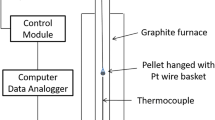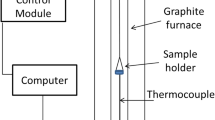Abstract
Evolution of the internal state of magnetite pellet during induration is defined by the kinetics of physico-chemical transformation it undergoes owing primarily to oxidation [< ~1273 K (1000 °C)] and sintering [> ~1273 K (1000 °C)] phenomena, along with the associated heat transfer. In the pursuit to simulate such evolution and properties of the magnetite pellet during induration, the respective oxidation and sintering kinetic models have been developed independently in previous studies. Oxidation model, which was built on the principles of grain model is capable of simulating the progress of oxidation at particle as well as at pellet scale, where kinetics of particle oxidation is suitably described by the Avrami mechanism. Similarly, sintering models at pellet scale were formulated by incorporating the deduced kinetic parameters for probable presence of both the phases—oxidized magnetite and non-oxidized magnetite. Subsequently, these independent models are integrated in a pertinent way to develop the single pellet induration model (SPIM), whose approach and formulation has been presented in this study. The methodology adopted will enable to simulate the internal state at any time during induration at pellet as well as particle scale for varying raw material mixes and the process parameters, such as temperature, O2 content and flow rate of the oxidizing gas. Thus, it can assist in optimizing the thermal and gaseous profiles in order to achieve the desired pellet properties, such as oxidation extent, type of reaction front, strength, etc.
Graphical Abstract
Simulation from the single pellet induration model (SPIM) predicting the evolution of internal state of magnetite at pellet a well as particle scale, when the temperature and O2 content in oxidizing gas is varied.











Similar content being viewed by others
Change history
28 August 2023
A Correction to this paper has been published: https://doi.org/10.1007/s11663-023-02892-4
Abbreviations
- \(\Delta H\) :
-
Heat of reaction
- \(N\) :
-
Number of cells
- \({T}_{1\to n}\) :
-
Temperature from 1st to nth cell in the pellet
- \({pO}_{2, 1\to n}\) :
-
Partial pressure of O2 from 1st to nth cell in the pellet
- \({\gamma }_{1\to n}\) :
-
Shrinkage from 1st to nth cell in the pellet
- \({V}_{1\to n}\) :
-
Volume of pellet from 1st to nth cell in the pellet
- \({\varepsilon }_{1\to n}\) :
-
Porosity of pellet from 1st to nth cell in the pellet
- \({\dot{{N}N}}_{{\text{O}}_{2}}\) :
-
Diffusion flux of O2
- \({D}_{eff}\) :
-
Effective diffusivity of the oxidizing gas
- \({D}_{{O}_{2}-{N}_{2}}\) :
-
Diffusion coefficient of gas comprising of O2 and N2, i.e., air
- \({X}_{{O}_{2}}\) :
-
Mole fraction of O2
- \(C\) :
-
Molar concentration of oxidizing gas
- \({N}\epsilon\) :
-
Porosity of pellet
- \({N}\tau\) :
-
Tortuosity of pellet
- \(r\) :
-
Radius of pellet
- \(\dot{G(r)}\) :
-
Number of moles of O2 consumed at any radial location \(r\) per unit volume of pellet per unit time
- \({N}_{p}\) :
-
Number of particles/grains per unit volume of the pellet
- \({N}{\delta }_{M,{Fe}_{3}{O}_{4}}\) :
-
Molar density of Fe3O4
- \(f\) :
-
Fraction of conversion by oxidation for the concentrate
- \({d}_{p}\) :
-
Diameter of pellet
- \(t\) :
-
Isothermal time
- \(a\) :
-
Avrami rate constant
- \(n\) :
-
Avrami time exponent
- \(K\) :
-
Arrhenius reaction rate constant
- \({K}_{0}\) :
-
Pre-exponential factor
- \(Q\) :
-
Activation energy
- \(R\) :
-
Ideal gas constant
- \({N}\rho\) :
-
Density
- \({C}_{p}\) :
-
Specific heat capacity
- \({k}_{eff}\) :
-
Effective conductivity
- \({H}_{Gen}\) :
-
Heat generation corresponding to local rate of oxidation
- \({N}\sigma\) :
-
Staffan-Boltzmann constant
- \({N}\varepsilon\) :
-
Emissivity
- γ :
-
Sintering extent
- \({{N}\gamma }_{total}\) :
-
Total sintering extent
- \({{N}\gamma }_{hem}\) :
-
Sintering extent of hematite phase
- \({\gamma }_{mag}\) :
-
Sintering extent of magnetite phase
References
K. Mayer: Pelletization of Iron Ores, Springer, Berlin, 1980.
S.P.E. Forsmo, S. Forsmo, P. Samskog, and B.M.T. Björkman: Powder Technol., 2008, vol. 183, pp. 247–59.
S. Dwarapudi, T.K. Ghosh, A. Shankar, V. Tathavadkar, D. Bhattacharjee, and R. Venugopal: Int. J. Miner. Process., 2010, vol. 96, pp. 45–53.
A. R. Firth, J. D. Douglas, and D. Roy: Iron Ore Proceedings, Perth, Australia, 2011, pp. 413-23.
O. Lacroix, M. Dube, R. Leclerc, G. Laforest, and A. Firth:2nd European Steel Technology and Application Days - METEC, Dusseldorf, Germany, 2015.
J. Mourão, M. Huerta, U. de Medeiros, I. Cameron, K. O’Leary, and C. Howey: ABM Annual Congress, Rio de Janeiro, Brazil, 2012.
J.R. Wynnyckyj and W.A. McCurdy: Metall. Trans., 1974, vol. 5, pp. 2207–15.
Veikko Niiniskorpi: Åbo Akademi, Process Chemistry Centre, 2004.
J.R. Wynnyckyj and T.Z. Fahidy: Metall. Trans., 1974, vol. 5, pp. 991–1000.
H. J. Cho and P. C. Pistorius: AISTech - Iron and Steel Technology Conference Proceedings, Indianapolis, 2011, pp. 507-14.
T.K. Sandeep Kumar, N.N. Viswanathan, H.M. Ahmed, C. Andersson, and B. Björkman: Metall. Mater. Trans. B, 2015, vol. 46B, pp. 635–43.
T.K. Sandeep Kumar, N.N. Viswanathan, H.M. Ahmed, C. Andersson, and B. Björkman: Metall. Mater. Trans B, 2016, vol. 47, pp. 309–19.
M. Tang, H.J. Cho, and P.C. Pistorius: Metall. Mater. Trans. B, 2014, vol. 45B, pp. 1304–4.
A. Eriksson, C. Andersson, H. Ahmed, A. Dahlin, T.K. Sandeep Kumar, and P. Semberg: ISIJ Int., 2021, vol. 61, pp. 1439–49.
A. Eriksson, C. Andersson, P. Semberg, T.K. Sandeep Kumar, A. Dahlin, and H. Ahmed: ISIJ Int, 2022, vol. 62, pp. 465–76.
HYBRIT, https://www.hybritdevelopment.se/. Accessed 11 Nov 2022.
J. Ripke and J. Kopfle. MIDREX H2: Ultimate Low CO2 Ironmaking and its place in the new Hydrogen Economy, https://www.midrex.com/tech-article/midrex-h2-ultimate-low-co2-ironmaking-and-its-place-in-the-new-hydrogen-economy/. Accessed 13 Nov 2022.
A. Martinis: Tata Steel chooses Energiron Dri Technology to take a major step into Green Steel Production, https://www.energiron.com/tata-steel-choose-energiron-technology/. Accessed 13 Nov 2022.
D. Pauluzzi, A. Giraldo, A. Zugliano, D. Nogare, and A. Martinis:AISTech - Iron and Steel Technology Conference Proceedings, Cleveland, USA, 2020, pp. 492–99.
S. Maggiolino: First Hydrogen based Energiron Dri Plant for Tenova in China, https://tenova.com/newsroom/press-releases/first-hydrogen-based-energiron-dri-plant-tenova-china. Accessed 13 Nov 2022.
SALCOS, https://salcos.salzgitter-ag.com/en/salcos.html. Accessed 13 Nov 2022.
M. Leithinger: The three pillars of decarbonization, https://www.voestalpine.com/blog/en/innovation-en/the-three-pillars-of-decarbonization/. Accessed 13 Nov 2022.
POSCO, https://newsroom.posco.com/en/posco-starts-to-design-the-hyrex-demonstration-plant/. Accessed 23 Nov 2022.
World Steel Association, https://worldsteel.org/steel-topics/environment-and-climate-change/climate-action/climate-member-initiatives/. Accessed 14 Nov 2022.
World Steel Association, https://worldsteel.org/steel-topics/environment-and-climate-change/climate-action/breakthrough-technology/. Accessed 14 Nov 2022.
M. Barati: Int. J. Miner. Process., 2008, vol. 89, pp. 30–9.
S. Sadrnezhaad, A. Ferdowsi, and H. Payab: Comput. Mater. Sci., 2008, vol. 44, pp. 296–302.
S. Majumder, P.V. Natekar, and V. Runkana: Comput. Chem. Eng., 2009, vol. 33, pp. 1141–52.
T. Thorat, N.N. Viswanathan, M. Basavaraja, M. Singhai, S. Hazra, and A. Mogale: Miner. Process. Extract. Metall., 2022, vol. 131, pp. 283–89.
T. K. Sandeep Kumar: Investigations on the Physico-Chemical Phenomena during Induration of a Magnetite Pellet, PhD Thesis, Luleå University of Technology, Sweden, 2018.
J. Szekely and H.Y. Sohn: Trans. Inst. Min. Metall. Sect. C, 1973, vol. 82, pp. c92-100.
J. Szekely: Gas-Solid Reactions, Academic Press, New York, 1974, pp. 143–51.
L. Doraiswamy and M. Sharma: Gas Solid and Solid-Solid Reactions, 1984, pp. 449–79.
T.K. SandeepKumar, N.N. Viswanathan, H. Ahmed, A. Dahlin, C. Andersson, and B. Bjorkman: Metall. Mater. Trans. B., 2019, vol. 50, pp. 150–61.
T.K. Sandeep Kumar, N.N. Viswanathan, H. Ahmed, A. Dahlin, C. Andersson, and B. Bjorkman: Metall. Mater. Trans. B., 2019, vol. 50, pp. 162–72.
M. Avrami: J. Chem. Phys., 1939, vol. 7, pp. 1103–12.
M. Avrami: J. Chem. Phys., 1941, vol. 9, pp. 177–84.
T.L. Bergman, F.P. Incropera, D.P. DeWitt, and A.S. Lavine: Fundamentals of Heat and Mass Transfer, Wiley, New York, 2011.
Acknowledgments
Authors thank the Hjalmar Lundbohm Research Centre (HLRC) for financially supporting the development as part of Ph.D. project, and thereafter the funding from Centre of Advanced Mining and Metallurgy (CAMM) and the strategic innovation program Swedish Mining Innovation (SMI), a joint venture by Vinnova, Formas and the Swedish Energy Agency to support the continued development is highly appreciated. Authors would like to extend their gratitude towards Ola Eriksson and Daniel Marjavaara, LKAB and Anders Dahlin, Alteco System (formerly LKAB) for their technical inputs in planning the experiments and developing the model. Appreciation are also due to Christer Stenström, Staffan Hedvall and Hamid Sefidari of LKAB Metlab, Lulea, Sweden for sample preparation for the microstructural evaluation.
Conflict of interest
On behalf of all authors, the corresponding author states that there is no conflict of interest.
Author information
Authors and Affiliations
Corresponding author
Additional information
Publisher's Note
Springer Nature remains neutral with regard to jurisdictional claims in published maps and institutional affiliations.
Supplementary Information
Below is the link to the electronic supplementary material.
Supplementary file1 (MP4 5752 kb)
Supplementary file2 (MP4 7360 kb)
Rights and permissions
Springer Nature or its licensor (e.g. a society or other partner) holds exclusive rights to this article under a publishing agreement with the author(s) or other rightsholder(s); author self-archiving of the accepted manuscript version of this article is solely governed by the terms of such publishing agreement and applicable law.
About this article
Cite this article
Sandeep Kumar, T.K., Viswanathan, N.N., Eriksson, A. et al. Development of Single Pellet Induration Model for Magnetite Pellet: A Holistic Approach. Metall Mater Trans B 54, 2951–2964 (2023). https://doi.org/10.1007/s11663-023-02879-1
Received:
Accepted:
Published:
Issue Date:
DOI: https://doi.org/10.1007/s11663-023-02879-1




